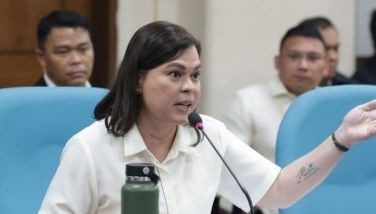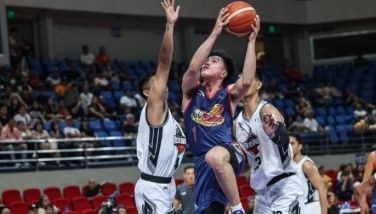Real estate boom back home
March 12, 2006 | 12:00am
Overlooking the crater lake of a volcano high above the heat and humidity of Manila, Dr. Emil and Ellen Suzara have built a home where they expect to live the rest of their lives.
The Suzaras took the profits from the recent sale of their home in Waimea on the Big Island to return to the Philippines to retire.
"The dollar is magnified here," says Dr. Suzara, who was a surgeon at North Hawaii Community Hospital. "You can live like a king and a queen."
The Suzaras, who were both born in the Philippines, are among a growing number of Filipinos from Hawaii and the U.S. mainland who are fueling a real estate boom here.
In Kalihi meanwhile, a steady stream of potential buyers talked with sales representatives from Robinsons Land Corp. about their high-rise luxury condominium projects in Metro Manila.
Over the two-day road show buyers put down refundable deposits to reserve units worth more than $700,000 or P37 million, according toVergil Adonis, a Hawaii broker who is helping to promote the sales of properties.
Bobit Pablo, the international sales manager for Robinsons’ high-rise building division, said the recent political crisis in the Philippines has not really affected business. He says Filipinos who were born in the country have grown up with coup rumors.
"In every crisis there’s an opportunity," Pablo says with the conviction of a salesman. The unrest means the U.S. dollar will buy more, and the condos he is selling are cheaper today if someone is ready to buy now.
Kevin and Zena Diaz Smith of Kaneohe sold their home last year and used half of their profit to buy a home and lot in Canyon Woods for about $200,000 and the other half for a down payment on a new home here.
On Saturday they put down a deposit for a two-bedroom condominium that sells for about $100,000. The Smiths say once the condo is paid off, they might move to the Philippines with their two children.
"We’re living paycheck to paycheck over here," says Kevin Smith, who works at Kaiser Medical Center.
The condo is near a private school and hospital. Smith thinks he should be able to get a job at the hospital, and they could either rent or sell their house here to supplement their income.
His Filipino co-workers at Kaiser are also thinking of moving back because they can now afford a nicer place and a better lifestyle, Smith says.
Smith has been to the Philippines three times, but his wife was born there. "I was challenged with it at first," Smith says about the poverty, politics, crime and other aspects of life in the Philippines. "But you can’t judge a book by its cover. The culture is incredible; the people are incredible."
Buying real estate in the Philippines is not for everyone, says Bob Bishop, former liaison to the Philippines for the president of the National Association of Realtors. It can be profitable and worthwhile, but people need to do their homework, he says. Land titles are not always clear, and disputes can be tied up in expensive court battles.
Bishop advises buyers to hire an attorney in the Philippines to look over the contract and investigate the title before signing any deal.
Most developments emphasize security; kidnappers sometimes target Americans for ransom, Bishop notes. The key in any real estate purchase is to make sure you are dealing with a reputable developer, Bishop advises.
Reputation is a selling point for Danilo Ignacio, general manager of Robinsons’ High-Rise Buildings Division. The company is affiliated with one of the largest conglomerates in the Philippines, with interests including airlines, banking, food, hotels, tele-communications and textiles.
Ignacio points out his window on the 32nd floor of the Ortigas Center in Metro Manila at an empty facade of a nearby building. The project is mired in debt after the Asian financial collapse in 1997, he says. It is a reminder of what can happen because of fraud or an underfinanced developer.
Robinsons survived the financial crisis and emerged a stronger company, Ignacio insists. "We delivered to our customers," he says.
In nearby Fort Bonifacio, a high-rise city is rising on part of a Philippine military base. Shopping centers, office buildings for the booming call center industry, and numerous condos are under construction. Robinsons has two condominium projects there, both of which are marketed in Hawaii.
Last month, on a tour of Fort Bonifacio, Pablo pointed to where the private St. Luke’s Medical Center is being built. The hospital is a selling point for retirees who fear medical care in the United States could eat up their savings, Pablo says.
Norman Oshiro, president and chief executive officer of Hawaii Food Products Inc., bought a one-bedroom condo for $35,000 at Robinsons’ Fifth Avenue development in Fort Bonifacio.
Oshiro might retire in the Philippines, but says he bought the condo more as an investment and a place to stay when he visits Manila. "It’s cheap," he says. "It probably went up already."
Oshiro is not Filipino, but is a member of the Hawaii Filipino Chamber of Commerce. Filipino co-workers in his office also bought units on the same floor.
The government, through the Philippine Retirement Authority and other agencies, is trying to encourage overseas Filipinos and foreign nationals to retire and buy property in the Philippines.
A dual citizenship law allows Filipino Americans to buy land and businesses.
Foreigners who buy condos can qualify for a special investment visa that will allow them to stay in the country. But while foreigners can also own condominiums and townhouses, there are restrictions on the purchase of land.
So far, Robinsons is concentrating its international marketing on Filipino workers in the United States, Ignacio says. But they are starting to look at the market for non-Filipinos overseas.
Units at McKinley Park start at about $55,145 for a one-bedroom and go up to $130,759 for a three-bedroom unit.
Pablo says he started marketing units in the United States in late 2004. Overseas purchasers now account for about 30 percent of the company’s sales and could rise to about half.
In Tagaytay, the Canyon Woods development was originally marketed as a weekend home for upper-middle-class families from Manila. But last month about 70 percent of the sales were to Filipino-Americans, Villa-Real says.
The numbers of Filipinos from Hawaii who are moving to the Philippines are still small, nothing like the numbers of people who moved to Las Vegas for a more affordable lifestyle.
But Dr. Suzara would not be surprised to see more people from Hawaii as neighbors.
"We have casinos here, too," he says.
The author is city editor of the Honolulu Star Bulletin. He accompanied Hawaii governor Linda Lingle on her visit to the Philippines last January.
The Suzaras took the profits from the recent sale of their home in Waimea on the Big Island to return to the Philippines to retire.
"The dollar is magnified here," says Dr. Suzara, who was a surgeon at North Hawaii Community Hospital. "You can live like a king and a queen."
The Suzaras, who were both born in the Philippines, are among a growing number of Filipinos from Hawaii and the U.S. mainland who are fueling a real estate boom here.
In Kalihi meanwhile, a steady stream of potential buyers talked with sales representatives from Robinsons Land Corp. about their high-rise luxury condominium projects in Metro Manila.
Over the two-day road show buyers put down refundable deposits to reserve units worth more than $700,000 or P37 million, according toVergil Adonis, a Hawaii broker who is helping to promote the sales of properties.
Bobit Pablo, the international sales manager for Robinsons’ high-rise building division, said the recent political crisis in the Philippines has not really affected business. He says Filipinos who were born in the country have grown up with coup rumors.
"In every crisis there’s an opportunity," Pablo says with the conviction of a salesman. The unrest means the U.S. dollar will buy more, and the condos he is selling are cheaper today if someone is ready to buy now.
Kevin and Zena Diaz Smith of Kaneohe sold their home last year and used half of their profit to buy a home and lot in Canyon Woods for about $200,000 and the other half for a down payment on a new home here.
On Saturday they put down a deposit for a two-bedroom condominium that sells for about $100,000. The Smiths say once the condo is paid off, they might move to the Philippines with their two children.
"We’re living paycheck to paycheck over here," says Kevin Smith, who works at Kaiser Medical Center.
The condo is near a private school and hospital. Smith thinks he should be able to get a job at the hospital, and they could either rent or sell their house here to supplement their income.
His Filipino co-workers at Kaiser are also thinking of moving back because they can now afford a nicer place and a better lifestyle, Smith says.
Smith has been to the Philippines three times, but his wife was born there. "I was challenged with it at first," Smith says about the poverty, politics, crime and other aspects of life in the Philippines. "But you can’t judge a book by its cover. The culture is incredible; the people are incredible."
Buying real estate in the Philippines is not for everyone, says Bob Bishop, former liaison to the Philippines for the president of the National Association of Realtors. It can be profitable and worthwhile, but people need to do their homework, he says. Land titles are not always clear, and disputes can be tied up in expensive court battles.
Bishop advises buyers to hire an attorney in the Philippines to look over the contract and investigate the title before signing any deal.
Most developments emphasize security; kidnappers sometimes target Americans for ransom, Bishop notes. The key in any real estate purchase is to make sure you are dealing with a reputable developer, Bishop advises.
Reputation is a selling point for Danilo Ignacio, general manager of Robinsons’ High-Rise Buildings Division. The company is affiliated with one of the largest conglomerates in the Philippines, with interests including airlines, banking, food, hotels, tele-communications and textiles.
Ignacio points out his window on the 32nd floor of the Ortigas Center in Metro Manila at an empty facade of a nearby building. The project is mired in debt after the Asian financial collapse in 1997, he says. It is a reminder of what can happen because of fraud or an underfinanced developer.
Robinsons survived the financial crisis and emerged a stronger company, Ignacio insists. "We delivered to our customers," he says.
In nearby Fort Bonifacio, a high-rise city is rising on part of a Philippine military base. Shopping centers, office buildings for the booming call center industry, and numerous condos are under construction. Robinsons has two condominium projects there, both of which are marketed in Hawaii.
Last month, on a tour of Fort Bonifacio, Pablo pointed to where the private St. Luke’s Medical Center is being built. The hospital is a selling point for retirees who fear medical care in the United States could eat up their savings, Pablo says.
Norman Oshiro, president and chief executive officer of Hawaii Food Products Inc., bought a one-bedroom condo for $35,000 at Robinsons’ Fifth Avenue development in Fort Bonifacio.
Oshiro might retire in the Philippines, but says he bought the condo more as an investment and a place to stay when he visits Manila. "It’s cheap," he says. "It probably went up already."
Oshiro is not Filipino, but is a member of the Hawaii Filipino Chamber of Commerce. Filipino co-workers in his office also bought units on the same floor.
The government, through the Philippine Retirement Authority and other agencies, is trying to encourage overseas Filipinos and foreign nationals to retire and buy property in the Philippines.
A dual citizenship law allows Filipino Americans to buy land and businesses.
Foreigners who buy condos can qualify for a special investment visa that will allow them to stay in the country. But while foreigners can also own condominiums and townhouses, there are restrictions on the purchase of land.
So far, Robinsons is concentrating its international marketing on Filipino workers in the United States, Ignacio says. But they are starting to look at the market for non-Filipinos overseas.
Units at McKinley Park start at about $55,145 for a one-bedroom and go up to $130,759 for a three-bedroom unit.
Pablo says he started marketing units in the United States in late 2004. Overseas purchasers now account for about 30 percent of the company’s sales and could rise to about half.
In Tagaytay, the Canyon Woods development was originally marketed as a weekend home for upper-middle-class families from Manila. But last month about 70 percent of the sales were to Filipino-Americans, Villa-Real says.
The numbers of Filipinos from Hawaii who are moving to the Philippines are still small, nothing like the numbers of people who moved to Las Vegas for a more affordable lifestyle.
But Dr. Suzara would not be surprised to see more people from Hawaii as neighbors.
"We have casinos here, too," he says.
BrandSpace Articles
<
>
- Latest
- Trending
Trending
Latest
Trending
Latest
Recommended




















